Easter Eggs in Jim Kay’s Illustrations for “Harry Potter and the Prisoner of Azkaban”
As we impatiently await the release of the illustrated edition of Harry Potter and the Goblet of Fire next week, we’re continuing our hunt for Easter eggs in Jim Kay’s art. Even the previews of his illustrations have us spellbound.
Kay’s striking depictions and hidden treasures deserve recognition. He cites Richard Scarry as an influence, saying “I think children like looking for details.” Last month we revealed 130+ subtle messages, references, and motifs inside Harry Potter and the Chamber of Secrets; now it’s time to dissect the details in Harry Potter and the Prisoner of Azkaban.
The following is the result of speculation and research as well as details revealed by Kay himself in interviews, on his website, and via Instagram.
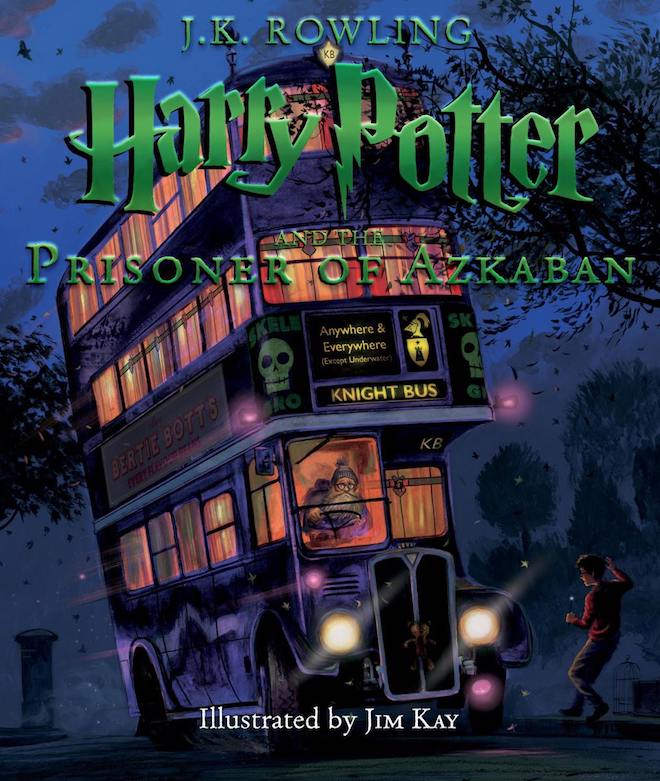
The cover of Prisoner of Azkaban depicts the Knight Bus. Along with stained glass windows and advertisements for Bertie Bott’s and Skele-Gro, Kay adorns the bus with a teddy bear strapped to its grille. Teddies have decorated trucks for decades, calling to mind ornamental carvings on bows of ships.
Flip the book over to discern the Grim. Don’t panic. It’s only Padfoot.
Azkaban’s ship graveyard darkens the atmosphere from the start. Kay declares, “Preliminary pages are a great way of getting images that you probably couldn’t justify showing in a book.” There’s a disconcerting skeleton among the wreckage on the second title page and a skeletal bird nesting beside the copyright information. This draws Mrs. Crouch to my mind since she died looking like her son and is buried outside the prison.
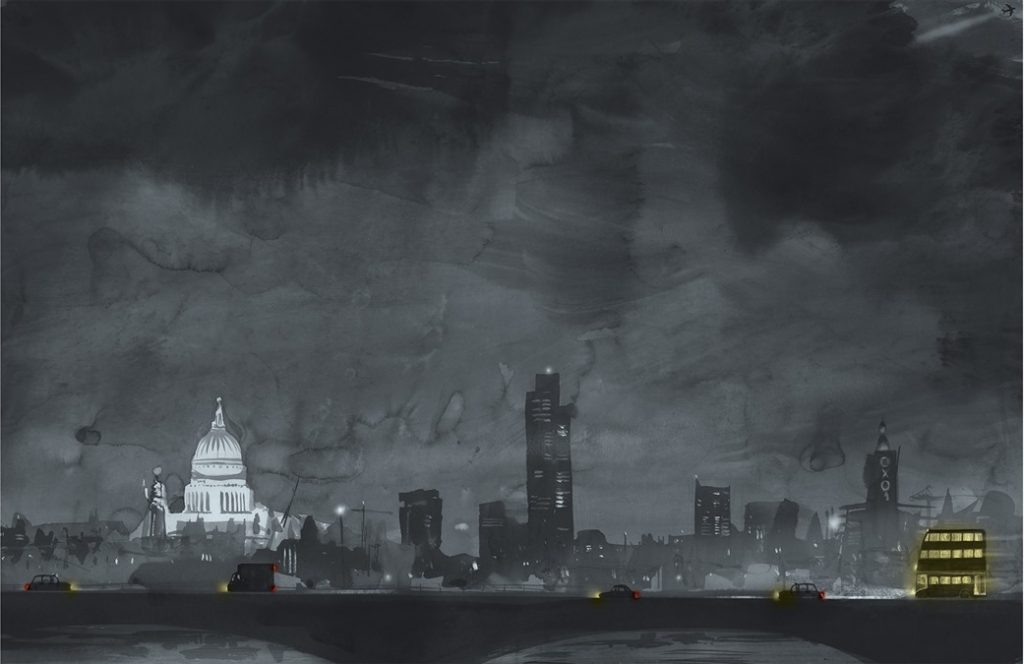
Like in Chamber of Secrets, Kay included real London buildings in his art. On pages 30–31, the Knight Bus drives west on the south bank of the River Thames on its way to the Leaky Cauldron, past the Oxo Tower and St. Paul’s Cathedral. This supports the notion that the entrance to Diagon Alley is located on Great Newport Street off Charing Cross Road.
The Leaky Cauldron’s tiles on pages 38–39 are painted with an assortment of figures including a leaky cauldron, a mandrake, a Snitch, and Deathly Hallows symbols.
Unfortunately, Kay did not offer any new shops for Diagon Alley. We do however see inside the Magical Menagerie a tooth fairy and a bird “reserved for Amelia,” Kay’s niece and model for Hermione.
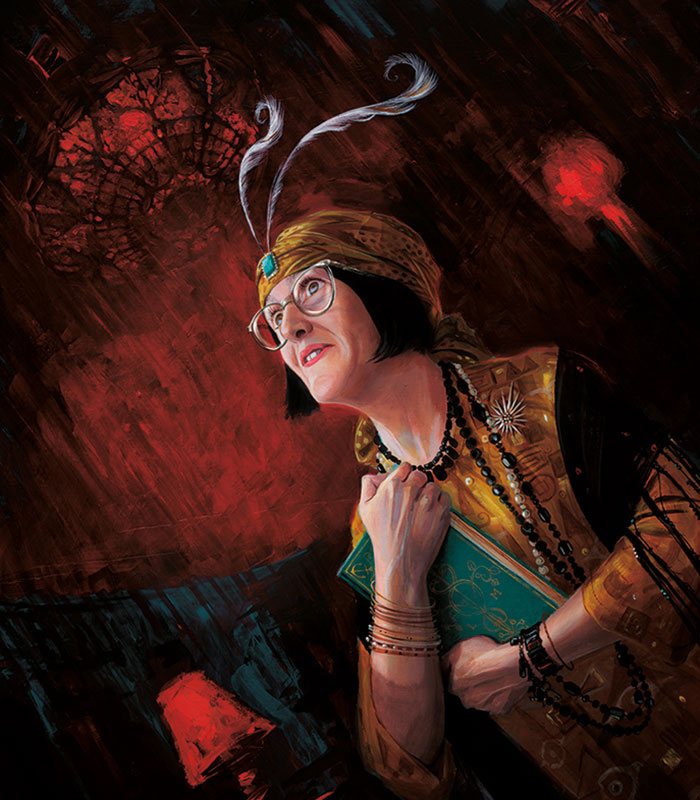
There appears to be a caduceus, the staff carried by Hermes in Greek mythology, on Trelawney’s book on page 79. Like Hermes, Trelawney brings news of what’s coming.
The hippogriffs on pages 86–87 are inspired by Mesopotamian friezes. In early drafts, they all had ears.
An ancient palindrome known as “Devil’s Verse” is carved into the wardrobe on page 92: In girum imus nocte et consumimur igni, or “we go into the circle at night and are consumed by fire.” The answer to this riddle is a moth, which might be Lupin ravaged by the moon (circle).

Kay writes, “Snape is based upon a striking gentleman I know called David.” Snape’s portrait on page 96 evokes Hans Holbein’s style and includes symbolism:
- There are Slytherin serpent motifs in his clothing.
- The scissors on the desk align with the name “Severus.”
- There’s a slug for Snape’s membership in the Slug Club.
- The mole in the jar represents Snape’s role as a double agent; like Snape, it is “dungeoned by this position.”
- Lily of the valley represents Snape’s love for Harry’s mother.
- The book labeled HBP foreshadows book six.
As usual, Kay emulates da Vinci with Grindylows (pages 118–119) and werewolves (pages 132–133).
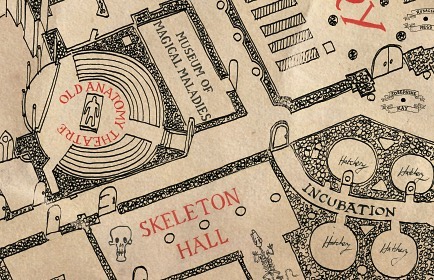
Kay plans to show more of the Marauder’s Map (page 148) in future books. For inspiration, he studied maps of old buildings like Hampton Court and Windsor Castle. He inserted friends like Clive Lundquist, who is recognized in the acknowledgments. He included rooms like a Herbarium, recalling his work at the Royal Botanic Gardens, but chose to forego an anatomy theater since “we figured children might not dissect bodies in school.”
On page 153, carved into the wall at the Three Broomsticks is tres faciunt collegium, “three makes company.”
The chocolate frog packaging (page 182) resembles a lily pad.
Kay’s beloved dog Leroy is memorialized on page 192 atop the heraldry.
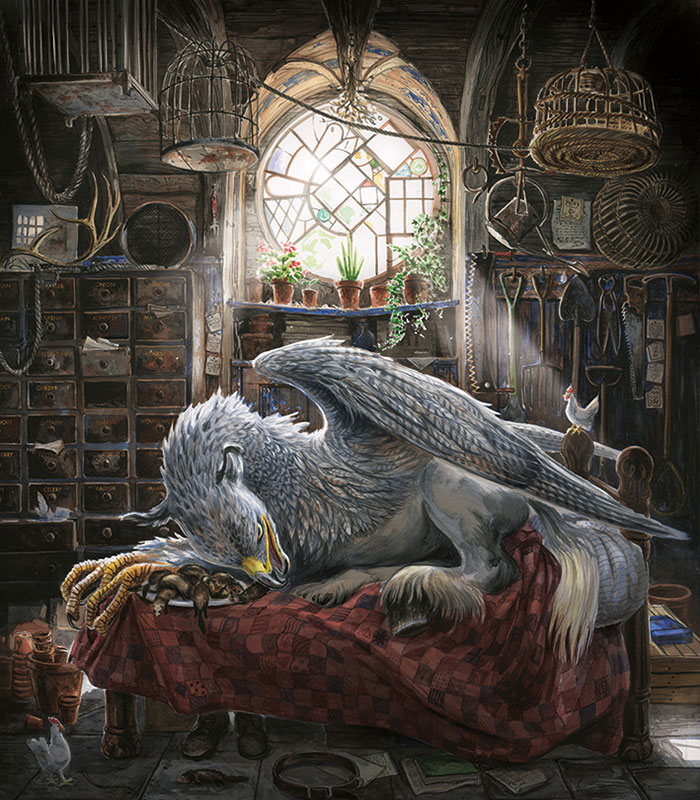
The next Deathly Hallows symbol is on Hagrid’s quilt on page 207. Kay based the hut interior on the Gardener’s building at Calke Abbey.
The tarot cards on page 219 offer insights:
- King of Swords represents mental strength; Harry and Hermione devise a plan to save Sirius and Buckbeak.
- Four of Cups indicates rumination; Hermione resolves to quit Divination.
- Lightning Struck Tower foretells destruction; Voldemort’s return is imminent after Wormtail’s escape.
- Death indicates change; subsequent books are darker in the fight against Voldemort.
- Five of Wands denotes competition; Harry’s team wins the Quidditch Cup for the first time in the books.
Finally, above Sirius on page 256 is Anubis and an ouroboros. Both represent rebirth; Sirius is reborn as an innocent in the eyes of Harry and Lupin. On the opposite page is a tribute to Bosch’s “The Garden of Earthly Delights.”
I can’t wait to immerse myself in Kay’s artwork for Goblet of Fire next week. Until then, let us know in the comments what you hope to see included.
